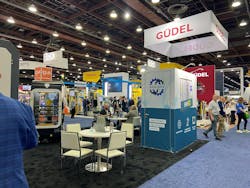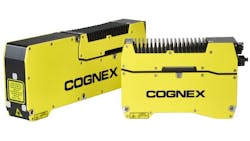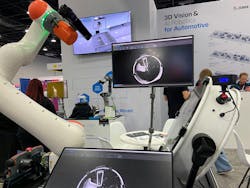Automate 2025: Machine Vision Technology Galore in Demos of Industrial Processes
Lights, camera, action.
That’s one way to characterize the machine vision and imaging technologies on display at Automate 2025, a large trade show hosted by the Association for Advancing Automation (Ann Arbor, MI, USA) May 12-15 in Detroit.
Multispectral Versus Hyperspectral Imaging
First, let’s discuss the lights.
Exaktera (Boston, MA, USA), which recently acquired several machine vision lighting companies including ProPhotonix, (Boston, MA, USA) displayed a variety of LED lighting technologies at the show.
One example was the COBRA NX MultiSpec from ProPhotonix, a multispectral line light available in four standard configurations: RGB, RGB-IR (855 nm), RGB-White (3500K) and RGB-SWIR (1150 nm, 1450 nm).
Launched this year, it is designed to be a less expensive option than the company’s original COBRA multispectral light, which can be configured with two to 12 wavelengths from 365-1500 nm.
Related: Exaktera Acquires autoVimation
With its broad spectral reach, the original COBRA light can be used for either multispectral imaging (which involves the use of a few wide spectral bands) or hyperspectral imaging (which covers a larger portion of the electromagnetic spectrum by using a larger number of narrow bands).
With the COBRA NX, “what we are doing is maximizing your performance versus cost ratio. It is meant to make multispectral imaging more accessible to the machine vision industry,” explains Matthew Branch, global product manager for LED standard products at Exaktera.
Automated Food Inspection
The light is a good choice when you don’t need the precise compositional analysis of an object that hyperspectral imaging delivers through its broad spectral reach, Branch says.
He explains that the less expensive multispectral light can be paired with a single- or dual-sensor monochrome camera for inspection applications in which you simply want to evaluate the presence or absence of certain characteristics. As Branch explains, “What percentage of fat is in this meat? Are there any bone fragments from the cutting process? Are there any foreign contaminants, maybe pieces of plastic?”
For this strategy to work, however, you need to know what wavelengths will allow you to see those characteristics. “If you know that ahead of time, you can simplify and cost-reduce the system to a multispectral light and a simpler camera,” Branch says.
Related: Condi Food Develops Hyperspectral Imaging Sorting Solution
On the other hand, if you want to know the exact chemical composition of an ibuprofen tablet, hyperspectral imaging would be a better choice, he adds.
2D and 3D Cameras for Product Inspection
In addition to lighting options shining brightly at numerous booths, countless cameras were on display at Automate, too. These included smart cameras with built-in deep learning capabilities.
Cognex (Natick, MA, USA) had each type at its booth.
One example is the company’s In-Sight 9912, a 12 MPixel area-scan camera that comes pre-built with deep learning-enabled algorithms that end users train directly on the camera.
“You are customizing them to whatever your application is,” Eric Hershberger, principal applications engineer at Cognex, explains. “They are very popular for end-of-line inspections, making sure everything has been assembled correctly,” he adds.
Related: AI Gains Physical Intelligence and Transforms Robotics and Automation Design
Cognex also displayed its AI-enabled 3D inspection system, the In-Sight L38 series. “These are our 3D laser (and) camera combination. We have different fields of view from 33 all the way up to 500 millimeters,” Hershberger says.
The system creates projection images that combine 3D information into a 2D image, which simplifies training of algorithms while also showing features of an object not typically captured with 2D imaging.
While the laser and camera combination has been “around for a long time,” according to Hershberger, the price has come down to a point “where it is cost-effective for everybody,” he explains.
He says the cameras—which come with either a red or blue laser—are suitable for challenging inspection tasks, such as checking the seals on nicotine patches or dents in battery casings.
Validating Machine Vision Inspection Applications
A feature of the Cognex cameras that Hershberger says he is particularly excited about is called Vision Validation. It is a new version of the company’s Test Run software. “It is built into the firmware because it is a very important thing to have,” he says.
The software is designed to alert users when they make a change to the parameters of vision software for a given application that could hamper the system’s ability to inspect parts correctly.
Related: When to Use Edge Learning in Machine Vision Applications
“Any change you make is going to be flagged, and that way we know something has changed. That will be output back to the PLC or your system. You can log that time and say, ‘Maybe parts from this time on might be bad. We might need to visually inspect them, or they might need to go into containment.’ It kind of depends on the plant process,” Hershberger says.
Cognex wasn’t the only booth featuring cameras. An option at another booth focused on action, or motion.
Capturing Images of Objects in Motion
Photoneo (Bratislava, Slovakia), now part of Zebra Technologies (Lincolnshire, IL, USA), has developed its own spin on structured light. A form of 3D imaging.
The company launched a new version of its flagship product: the MotionCam-3D Color (Blue) the week after Automate. The new version features a blue laser to scan scenes and objects in motion.
In a traditional structured light setup, multiple patterns of light are projected on to an object or scene However, “the prerequisite for that is the object and the camera need to be static because you are projecting patterns one after another, and then you overlap them and do the calculations to create x, y, z information for every pixel,” explains Tomas Michalik, director of global key accounts at Photoneo.
Related: Four Considerations for Ensuring Optimal Video Stabilization for Cameras in Motion
In contrast, Photoneo’s patented process, called parallel structured light, allows the camera to image objects and scenes in motion. “Instead of projecting those patterns on the scene, we are doing a very fast swipe of a laser line across,” Michalik says. “We do it for the whole scene—not just a line,” he says.
The company’s technology is incorporated into the MotionCam-3D Color (Blue) camera, which scans objects moving up to 40 m/s without halting production lines.
Photoneo also says it’s possible to operate versions of the MotionCam-3D with red and blue lasers simultaneously in multi-camera setups.
In its press release, Photoneo says the latest-generation camera can scan objects at distances of 4 m, or 13 ft, which is suitable for applications such as pallet scanning or car body inspection.
About the Author
Linda Wilson
Editor in Chief
Linda Wilson joined the team at Vision Systems Design in 2022. She has more than 25 years of experience in B2B publishing and has written for numerous publications, including Modern Healthcare, InformationWeek, Computerworld, Health Data Management, and many others. Before joining VSD, she was the senior editor at Medical Laboratory Observer, a sister publication to VSD.




